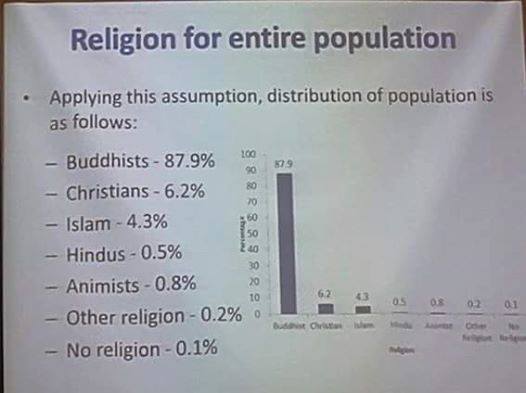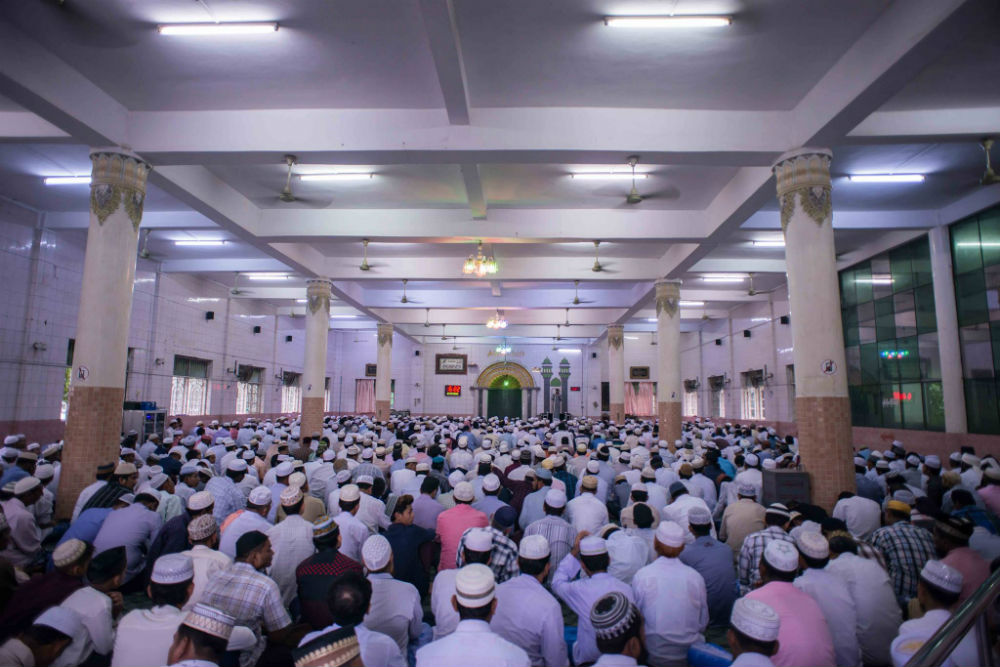Myanmar has finally released its religion data from the 2014 census, and one figure stands out.
Muslims only make up 2.3 percent of Myanmar’s 51 million people, said U Thein Swe, Minister of Labor and Immigration, at the official release of the data at the Max Hotel in Naypyitaw, the capital.
Buddhists represent 89.8 percent, while Christians were the second-largest religious group, at 6.3 percent. Animists make up 0.8 percent, while Hindus represent 0.5 percent. “Other religions” was listed as comprising 0.2 percent of the population, and 0.1 percent of people marked atheist.
Even when considering that the majority of Muslims in Rakhine state – hundreds of thousands of people – did not take part as “Rohingya” was not listed as a possible ethnicity, the estimated total percentage would still be 4.3 percent, Thein Swe said.
Here’s the graph taking into account those figures.

The Muslim population was thought to be much higher. Way back during the census in the 1980s, the figure was at 4 percent.

The data was delayed so as to not to stoke religious tensions, with the thinking being that if the number were much higher, it would give Buddhist hardliners fuel for anti-Muslim campaigns.
Groups such as the Buddhist Ma Ba Tha have used fears that their religion is threatened by Islam to justify actions, such as supporting the passage of four race and religion laws that, among other things, placed new bureaucratic hurdles in the way of interfaith marriage.
Interfaith tensions have dogged Myanmar for decades but exploded in 2012 with Buddhist-Muslim clashes in Rakhine state that led to scores dead and the creation of internal displacement camps for the Rohingya Muslim minority, which the government insists on referring to as “Bengali” or immigrants from Bangladesh.
The Christian population could also be higher as fighting between the military and ethnic groups in places like Kachin State – which has a large Christian population – meant the lack of comprehensive data collection.
In a phone interview, Al Haj U Aye Lwin, a prominent Muslim community leader in Yangon, disputed the statistics.
“I think the result is wrong,” he said.”I think it is a technical error by them which is not intentional. Muslims in Yangon and Mandalay could even be at least 2 million [people].”
Matthew Smith from Fortify Rights, which monitors the situation in Rakhine, echoed Lwin’s comments in an email.
“Generally speaking I’d say the census was fundamentally flawed due to exclusion of most Muslims in Rakhine State, so the findings on religious affiliation are inaccurate,” he said. “But regardless, there was no convincing argument for including religious data in the census.”
Hmuu Zaw, a spokesman for the president’s office, declined to comment as he had not examined the data.




